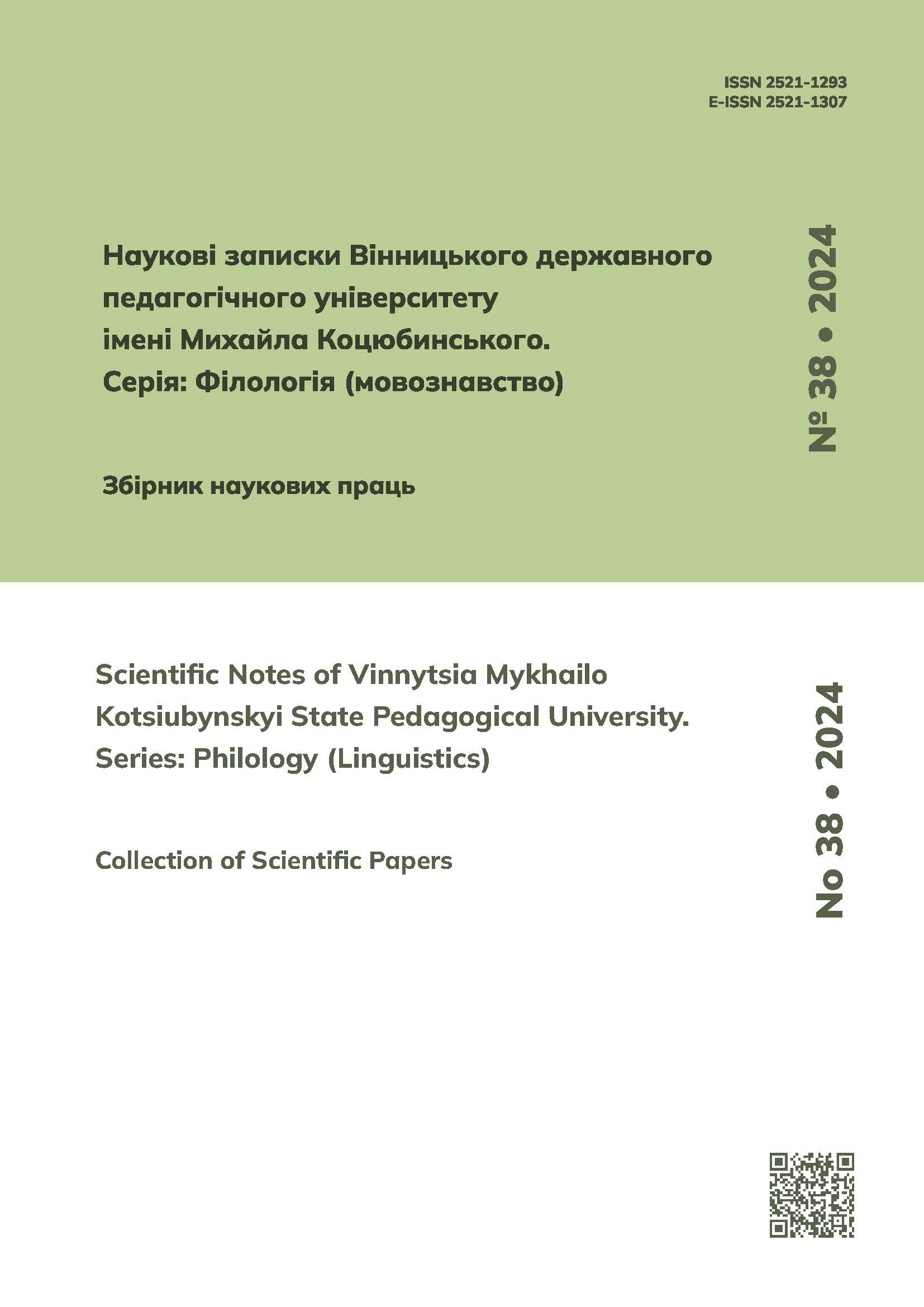Associative experiment as a means of studying the role of sacrality in the linguistic consciousness of the modern youth
https://doi.org/10.31652/2521-1307-2024-38-01Published 2024-08-13
Keywords
- free associative experiment, sacrality, linguistic consciousness, anthroponymic concept, nuclear and peripheral zones of an associative field
Copyright (c) 2024 Liudmyla Zhvania, Oksana Nesterchuk, Raisa Khrystianinova

This work is licensed under a Creative Commons Attribution 4.0 International License.
How to Cite
Abstract
This article presents the analysis of the results of a free associative experiment conducted to investigate the role of sacrality in the linguistic consciousness of a student youth. By choosing proper names for the role of words-stimuli, we analysed the semantics of the associative field of concepts-anthroponyms and determined the frequency of reactions related to the notion of sacrality. The purpose of the article is to study the sacred component in the language consciousness of students which opens the way to find out if traditional elements of the sacred have a functional significance in the perception of the world and formation of a picture of the world of modern youth. In the article the objectives are performed in the following way: we separated a part of the processed material, namely those anthroponyms-stimuli semantics of which traditionally includes elements of the sacred; the proportion related to the sacred was highlighted in the semantics of associative fields of anthroponyms-stimuli; certain semantic groups were identified depending on the content of the sacred in the associative field of concepts-anthroponyms; nuclear and peripheral zones were singled out in the associative fields of those concepts-anthroponyms, that caused reactions related to the concept of the sacred; the research analysed one of the results obtained - an article on an anthroponym-stimuli, the reactions to which were most often associated with the sacred.The research methods are determined by the purpose and objectives. In our research we used a free associative experiment, the method of linguistic description and its main technique: systematisation of linguistic material in synchrony. The quantitative method was used to calculate the number of anthroponyms-stimuli that most often triggered a reaction related to the concept of the sacred. The results testify to the fact that: the elements of sacrality form an essential part in the semantics of the associative fields of concepts-anthroponyms; sacrality is most often associated with the male names and the most responses associated with sacrality were found in the peripheral zone of the associative fields of the proposed stimuli. Depending on what content the sacrality element acquires in the associative fields of the anthroponymic concepts we distinguished the following semantic groups: God as the sacral personification of the Absolute, the Bible, biblical parables, characters and images; church, in two meanings: a community of believers of one religion and a temple in which Christian worships take place and everything connected with this concept; religion as a special system of worldview and perception of a particular person or group of people as well as a set of beliefs and doctrines available in society; representatives of the clergy, saints, martyrs and holidays related to their commemoration. Originality. The scientific novelty lies in the fact that for a free scientific experiment names and their variants are proposed, the semantics of which contains elements of the sacred. Conclusion. The analysis of the research results confirms, that the most powerful semantic group is comprised of the mythological characters and images that came to us from the Bible. Traditional sacrality has functional significance in shaping the world image of the modern youth, which indicates how much is the younger generation deep-rooted in the religious traditions of the nation.
Downloads
References
- Бацевич, Ф. (2009). Основи комунікативної лінгвістики. Київ: ВЦ «Академія», 376 с.
- Бацевич, Ф. (2007). Словник термінів міжкультурної комунікації. Київ: Довіра, 205 с.
- Бутенко, Н. (1979). Словник асоціативних норм української мови. Львів: Вища школа, 118 с.
- Гапченко, О. (2011). Мовна свідомість людини як об’єкт лінгвістичних досліджень. Вісник Київського національного університету ім. Т. Шевченка: Літературознавство. Мовознавство. Фольклористика, № 22, С. 31–34. http://nbuv.gov.ua/UJRN/VKNU_LMF_2011_22_12
- Гнатюк, Л. (2005). Мовна свідомість у сучасній лінгвістичній парадигмі. Українське мовознавство, Вип. 34, C. 3–8.
- Дюркгайм, Е. (2002). Первісні форми релігійного життя: Тотемна система в Австралії. Київ: Юніверс, 2002, 424 с.
- Ковалевська, Т. (2013). Прикладні аспекти укладання асоціативних словників. Українська і слов’янська тлумачна і перекладна лексикографія. 2013, С. 140–146.
- Ковалевська, Т. (2001). Семантика онімних асоціатів у рекламному дискурсі. Записки з ономастики, 2001, Вип. 5, С. 3–11.
- Кочерган, М. (2004). Зіставне мовознавство: проблема мовних картин світу. Мовознавство, № 5–6, С. 7–22.
- Нестерчук, О. (2019). Асоціативний словник власних особових імен. Луцьк: ПП Іванюк В. П., 2019, 200 с.
- Селігей, П. (2012). Мовна свідомість – шанобливе ставлення до мови. Дивослово, № 7, С. 40–44.
- Сурмач, О. (2012). Асоціативний експеремент та вербальні асоціації у психолінгвістичних дослідженнях. Наукові записки Національного університету «Острозька академія». Сер. Філологічна, Вип. 29, С. 22–24.
- Швець, Ю. (2021а). Динаміка густативів на матеріалі твору «Кайдашева сім’я» І. Нечуя-Левицького. Прикладна лінгвістика на Півдні України: здобутки та перспективи: зб. матер.І Міжнар. Конгресу, Одеса, С. 121–125.
- Швець, Ю. (2021б). Дослідження кодів української густаторної лексики методом вільного асоціативного експерименту. Актуальнi питання гуманiтарних наук. Вип. 44, т. 3, С. 146–154.
- Шелюто, В. (2010). Проблема сакрального як світоглядна проблема. Наука. Релігія. Суспільство, 2010, № 4, С. 91–94.
- Otto, R. (1950). The idea of the holy. Oxford and New York: Oxford University Press. 1950. http://faculty.trinity.edu/mbrown/whatisreligion/PDF%20readings/Otto-Idea%20of%20the%20Holy-cmb%20highlights.pdf





